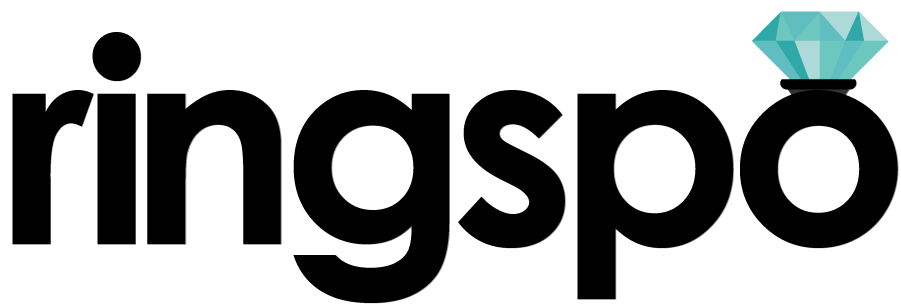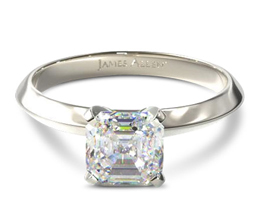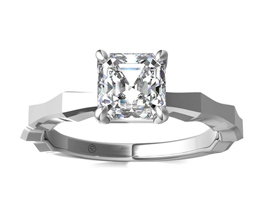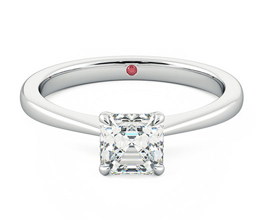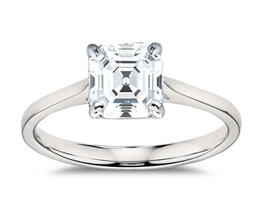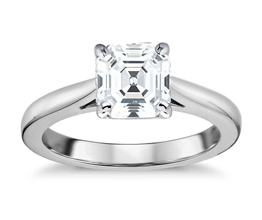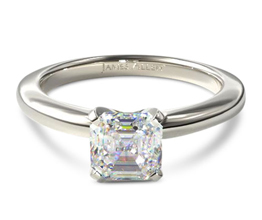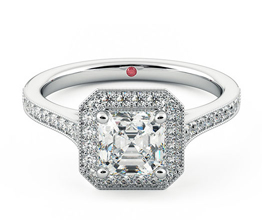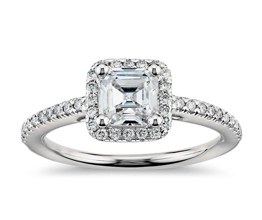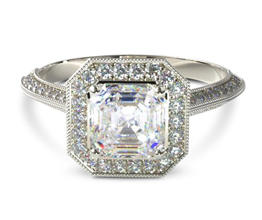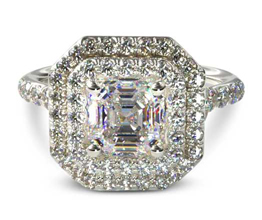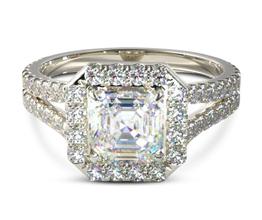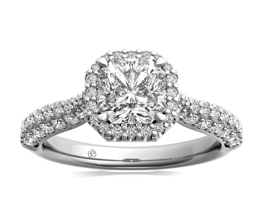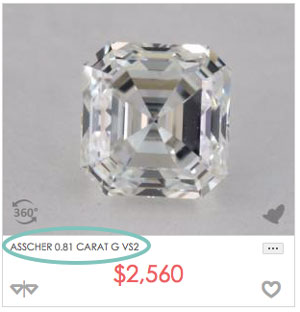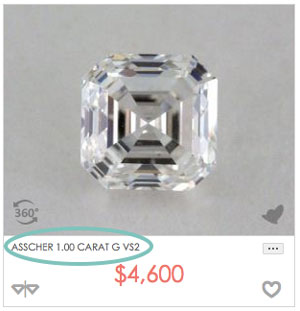Asscher cut engagement rings
How to get the best asscher cut diamond for your budget
Ringspo is reader supported
Ringspo is reader-supported, which means we may receive a commission if you click a link to a retailer & subsequently make a purchase.
We feature links to several retailers to help readers find the one that is the best fit for them. Find out more about how Ringspo works here.
Asscher cut engagement rings are a classic cut, but one that is coming back into fashion as Hollywood celebs like Angelina Jolie have chosen it for their engagement ring.
You’ll learn:
- What’s good about Asscher cut engagement rings
- What’s bad about Asscher cut engagement rings
- Asscher cut engagement ring setting style inspiration
- An Asscher cut diamond buying guide to let you know what you really need to know
- Recommended specs for an Asscher cut diamond
Do you know about the 4Cs?
Much of the information on this page will focus on diamonds, as getting that right is key to getting an awesome ring for a great price. If you’re not familiar with the 4Cs of diamonds then I’d recommend reading this page which gives an overview of what you really need to know.
The Asscher shape diamond was developed in 1902 by a chap named Joseph Asscher and it’s basically a square version of the emerald cut, with squared off corners and ‘stepped’ sides.
In fact, it’s more officially know as a ‘square emerald’.
Due to its symmetrical shape and the squared off corners at the top and bottom of the stone, an ‘X’ can usually be seen in the top table of the diamond.
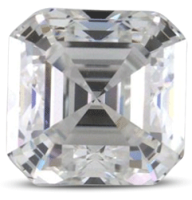
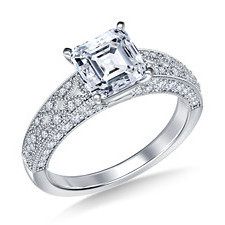
More than a century after the original Asscher cut was invented, the Asscher family are still a prominent jeweler family in the Netherlands.
In 2001, Joseph Asscher’s great, great grandsons Edward and Joop Asscher developed a revised version called the ‘Royal Asscher’ cut to celebrate 100 years since the original cut was invented.
The Royal Asscher takes the knowledge gained of how diamonds affect light and added more facets to the original design, to allow it to sparkle more brilliantly. However, most of the Asscher cuts that you see will be the standard shaped standard Asscher cut.
Original Asscher Cut
The original Asscher cut was developed just as the art deco period was kicking off, and in keeping with the design ideals of the time, it features straight lines and an interesting geometric form. It therefore makes the perfect center stone for a retro art deco style ring.
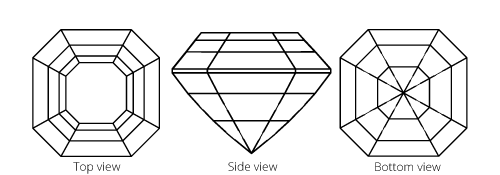
Royal Asscher Cut
The new and improved Royal Asscher used an updated understanding of how light is affected by diamonds, with a higher crown and smaller table which give more brilliance and fire than either the standard Asscher or the emerald cut.
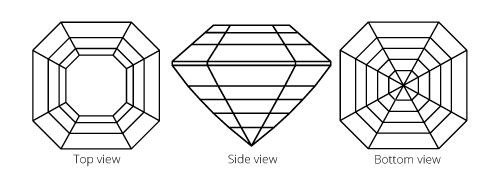
International Asscher cut guides
Each country has its own retailers we’ve therefore created individual asscher cut guides for different countries. If you live outside the US, click below to access your local guide:
What’s good about Asscher cut engagement rings?
Asscher cut diamonds are well-priced
Square cuts like the Asscher are a really efficient way of reducing the amount of wastage in the process of transforming a diamond from a piece of rough stone to the shiny and polished gemstone that you buy.
Compared with a round brilliant stone, around 20% more of the original diamond rough can be used. This means that a much smaller piece of rough diamond is required to produce a finished ring of any size, and a small piece of rough diamond is obviously cheaper.
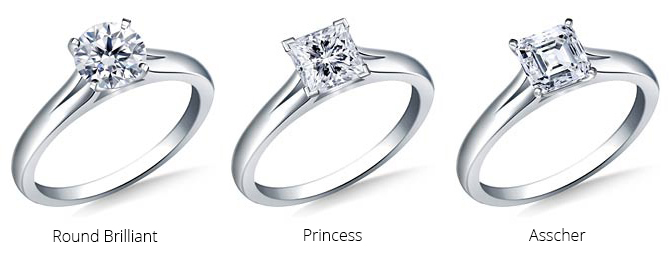
Asscher cuts are also a slightly simpler shape to create than some others, so less technical expertise and time is required, which results in lower labour costs which can be passed on to you, the end consumer.
The table below shows the price difference between a round brilliant diamond, a princess cut diamond and an Asscher cut at the same size and quality, found through one of my recommended retailers.
- 1 carat
- Color F
- Clarity VS1
Here’s how the pricing compares:
| SHAPE | PRICE (US$) | DIFFERENCE (US$) | DIFFERENCE (%) |
|---|---|---|---|
| Round Brilliant | 6,610 | ||
| Princess | 4,446 | -2,164 | -32.7 |
| Asscher | 3,720 | -2,890 | -43.7 |
That’s an absolutely huge 44% saved over a round brilliant for stone which is exactly the same carat weight and quality. And the Asscher shape is over 10% cheaper than the Princess cut too.
The size and specs that you are looking for will change the exact savings that can be achieved – you might save more, or you might save less, but there will always be a significant saving available.
Asscher cut diamonds are durable
Compared to some square cuts e.g. the Princess, the Asscher cut is more resilient and less likely to get damaged. With its squared off corners, its unlikely to get snagged on clothing and as there are no delicate edges exposed, it’s less likely to get chipped.

Asscher cut diamonds are unique
Lastly, Asscher cuts are a classy and individual choice. You’re unlikely to find many others out there in a sea of round brilliant and Princess cuts, so they have a real air of exclusivity.
What’s bad about Asscher cut engagement rings?
Asscher cut diamonds need higher stone quality
The biggest downside of Asscher cuts is that it needs a higher quality stone that some other shapes out there.
The large top table of the ring means that any clarity flaws are more likely to be noticeable and grades that would be ‘eye clean’ in other stones e.g. VS2 may still have flaws that are visible to the naked eye when examined closely.
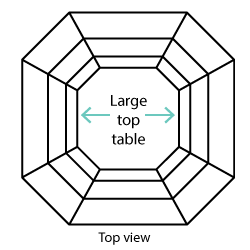
It’s therefore important if you’re planning on buying a stone at VS2 or below that you can inspect magnified images of the individual stone that you are looking to buy, to confirm that it is eye clean and no flaws are visible. At grades above VS1 then all stones will be eye clean, and although it’s still a good idea to examine the actual stone if possible, it’s not as essential.
Color is more visible on Asscher cut diamonds than on other shapes
You are also more likely to notice yellow colour creeping in at lower colour grades than with other shapes which have been cut to maximise brilliance. Shapes like like the round or the Princess ‘chop up’ the light, and hide imperfections through the fire and scintillation, but you can’t rely on Asscher cuts doing this to nearly the same degree.
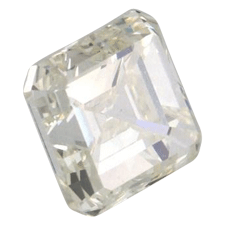
Both of these factors mean that you may need to go for a stone that is graded higher in clarity and colour, which will increase the price.
Asscher cut diamonds appear smaller than other shapes
Lastly, a lot of the weight of an Asscher cut diamond is underneath the ‘girdle’ of the stone ie. on the bottom half. This means that when it’s mounted in a ring, it’s basically invisible.
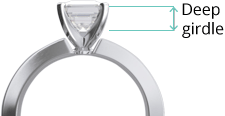
The diagrams below a 1 carat round brilliant and a 1 carat Asscher to scale.
The round brilliant cut is less deep and has a wider ‘spread’, which means that at a set carat weight, it will appear larger.
As we saw earlier, a 1 carat Asscher diamond is significantly less expensive than a 1 carat round brilliant stone, so you could increase the carat weight so that the stone is the same size and still save money over an equally wide round brilliant if you wanted.
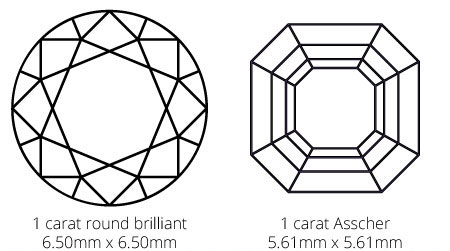
Asscher cut engagement ring settings
While it’s important to get the best center stone that you can for you ring, it’s the ring setting that really defines the character of the ring.
This settings below are by no means a definitive collection, but is a selection to show the variety available within each setting style. If you see a setting style that you like, click through to find out more about it.
Solitaire Asscher cut diamond rings
The classic solitaire is still the most popular ring style. It suits any shaped diamond and any metal, while being budget-friendly due to its simplicity. It’s a great choice to ensure that as much light can enter your diamond as possible, meaning that it will sparkle as brightly as possible.
Scroll across to check out a selection of Asscher cut solitaire engagement ring options, and click through to find out more about each one.
Asscher cut halo diamond engagement rings
Halo settings are a great way of maximizing the visual impact of a ring, as the stones surrounding the center stone catch the light and add their sparkle.
An added advantage is that it will create the illusion of a large rock, even with a modestly-sized center stone.
Asscher cut diamond buying guide
‘Fancy’ shaped diamonds (ie. any shape other than round) go in and out of fashion, and the more fashionable a stone shape is at any one point in time, the more rough diamonds will be cut to that shape and the easier stone will be to find as there will be more available to jewelry retailers.
Asscher cut stones aren’t one of the more popular diamond shapes at the moment, which means that your local jeweler may have a very limited selection of Asscher cut engagement rings, or possibly even none at all.
Online jewelers will have a larger selection of Asscher cut stones available, and are your best bet to ensure that you get a quality stone at a great price.
In this section, you’ll learn exactly what you need to know about the 4Cs of Asscher diamonds, to you get a beautiful stone and great value.
This section does go into a lot of detail, but it’s definitely worth taking the time to read to make sure that you get the best stone you can for your Asscher cut engagement ring. At the end, I’ll sum up all of my recommendations so that it’s easy for you to refer back to.
Asscher cut diamond cut quality
Unlike some diamond shapes there are no set ‘ideal proportions’ for an Asscher cut diamond. Some retailers will give a grade for Asscher cut stones, but their gradings have just been developed by the retailers themselves, rather by an independent authority.
There are some stats around an Asscher cut’s proportions to look at when choosing a diamond though, to make sure that you get a stone with great ‘optical performance’:
Asscher diamond length / width ratio
The perfect Asscher cut is a square when viewed from above, so it’s length and width should be equal – this is a 1:1 length / width ratio. However, in reality, many Asschers aren’t quite square and a L/W ration of anywhere up to 1:1.15 can be found.
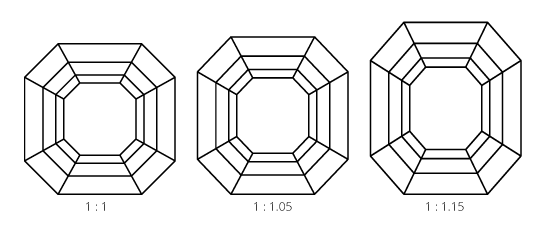
When mounted in a ring, anything up to a 1:1.05 will look absolutely fine – you wouldn’t be able to tell that it isn’t a perfect square. Of course, you can go above this if you want and stones will generally be lower in cost if you do. Adding side stones to the setting can help to disguise a stone that has a higher length / width ratio.
There are also two primary characteristics you want to pay attention to when looking at proportions. These are depth percentage and table size which are both expressed as percentages in a grading report.
Asscher cut diamond depth percentage
Depth percentage is the depth as a percentage of the width of the stone.
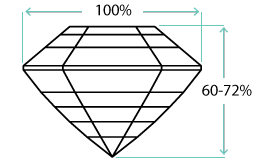
For some shapes, like the round brilliant, this is super important as the correct proportions are required to make sure as much light is reflected back to your eye and the stone sparkles as much as possible.
For Asscher cuts, where a lot of the light is reflected off the surface of the diamond rather bouncing around inside and then being reflected back out, it’s less important.
However, my recommendations to ensure that the most light possible is reflected back is:
| Excellent | Very good | Good |
|---|---|---|
| 60% – 72% | 56% – 76% | 54% – 78% |
Asscher diamond table percentage
Table percentage is the width of the top ‘table’ of a diamond (the flat are on top) expressed as a percentage of the total width of the stone. Again this is an important ratio because the proportions here will affect how light is reflected within the stone and therefore how much is reflected back to your eyes, making the diamond sparkle.
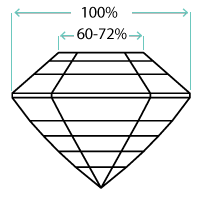
| Excellent | Very good | Good |
|---|---|---|
| 60% – 72% | 55% – 74% | 50% – 76% |
Asscher diamond color
As mentioned earlier, Asscher cuts are less good at hiding lower color grades than other diamond cuts which can hide a lower color behind the sparkle. Although color can bu subjective and some people prefer the warmer colours of less white diamonds, we recommend going down to G as the very minimum if you want to ensure that your stone doesn’t appear yellow at all.
As with all diamonds, it’s very difficult to tell the difference between the higher colour grades – D, E and F are virtually indistinguishable unless you are a trained professional and examining them next to each other.

Very white
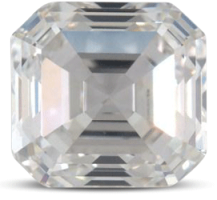
Recommended – great balance of colour and value
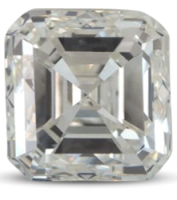
Warmer tones
Asscher cut diamond clarity
While for some stone shapes you can buy using a grading report, knowing that a SI1 clarity stone will definitely be eye-clean, with an Asscher cut stone it’s not so easy unfortunately. I mentioned the large table on the top of the Asscher cut earlier and the fact that it can make inclusion in the stone more easily seen, and although some SI1 clarity stones may be eye clean, it you’re planning on going for an SI1 stone it’s good idea to use a retailer that allows you to examine the exact stone that you’re looking to give yourself peace of mind.
James Allen is my recommendations for purchasing an Asscher cut ring as they have high quality photography of each individual stone, allowing you to ensure that you are getting a high quality and eye clean stone. Ensure that you pay special attention to the top table of the stone when looking for flaws to make sure that none are visible.
If you are looking for a higher clarity grade then inspecting the individual diamond isn’t so important as the stone will definitely be eye-clean, so any of my other recommended retailers would also be a great choice.
Asscher diamond carat
A diamond’s carat weight is something that people often get overly hung-up on. ‘How big is it?’ is often the first question people ask when they see an engagement ring, which means that buyers want to make sure that their ring can compete with their friends. However, carat weight is definitely not the most important attricube of a diamond, and you shouldn’t make sacrifices on other attributes of the stone just to increase the carat weight up to a certain size.
The relationship between a diamond’s carat weight and its visible size isn’t always a direct one. When we judge a diamond’s size, we look at it from the top – known as the ‘face up’ position in the jewelry trade. However, much of the weight of a diamond is actually carried on the bottom half of the stone, where it can’t be seen.
The images below show the difference in size for Asscher cut diamonds at a range of carat weights:
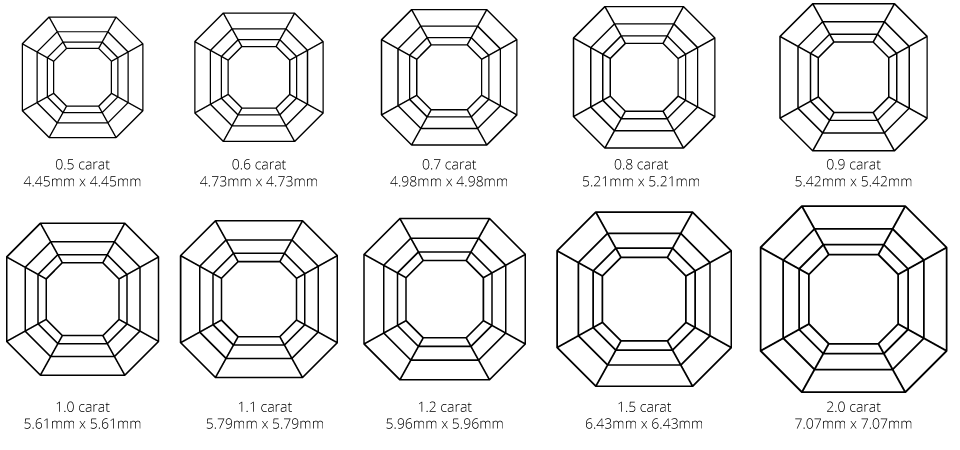
Hopefully you can see that increasing the carat weight doesn’t necessarily translate into a much visibly larger diamond. Changing the size from 0.8 carat to 1 carat is an increase in width of 0.4mm – less than 10%. However, the difference in price will be much more significant – an 80% increase:
The priority that you place on diamond carat weight and how big you want to go is totally up to you. However, I would recommend that you don’t make it the most important thing when choosing your engagement ring.
Find a setting you love, pair it with a diamond with a great cut that is going to sparkle dazzlingly, make sure that it is eye-clean and has good color and then see what carat weight you can fit into your budget.
A well-rounded diamond will be much more impressive than a big stone that is dull or has obvious imperfections.
Asscher diamond certification
The fifth C, and a very important one too. When looking at any diamond, you need to ensure that any diamond that you’re looking at is a ‘cert stone’, which means that it has been assessed, graded and coded with a laser by an independent lab.
Each certificate has a unique report number and detailed information about the stone, covering the four Cs, the height, depth and other info. As well as providing assurance that the stone that you’re buying is the quality that you are paying for, a certificate also proves what you’re buying is not a substitute.
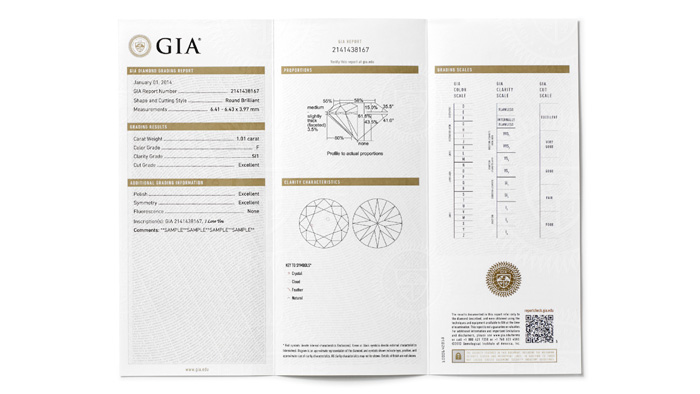
The lab to trust and to look for certification from is the non-profit Gemological Institute of America (GIA). It’s the most internationally recognised and generally seen as the most impartial of all of the gem labs.
The reason that the GIA is so well respected is because most others labs are part of trade bodies that contain jewelry retailers, or are ‘for profit’. While the GIA is very consistent with its gradings, the others have a reputation for being overly generous. What the GIA say is merely a diamond with a ‘good’ cut, maybe be graded ‘excellent’ by another lab, with an excellently large price to match.
Diamond certificates are what makes buying online safe and the best way to get a fantastic diamond at the lowest price. Knowing that each diamond you’re considering has been measured and graded by independent experts allows you to make an informed decision. You can take your time to consider the differences between diamonds and make sure you choose what experts have graded as the best stone, meaning that you get your perfect engagement ring at the best possible price.
Recommended Asscher Cut Diamond Specs
These specs are the minimum that we recommend to ensure that the diamond on your Asscher cut engagement ring looks fantastic.
You can of course go higher than these specs, if your budget allows, but for many of the characteristics you are paying for improvements that are very difficult, if not impossible, to see by the naked eye, especially when mounted in a ring setting.
If you’re unsure about what any of these terms mean, check out this page which talks you through them all.
Clarity: VS2
Colour: G
Length / Width ratio: 1.00% – 1.05%
Table %: 60 – 72%
Depth %: 60 – 72%
